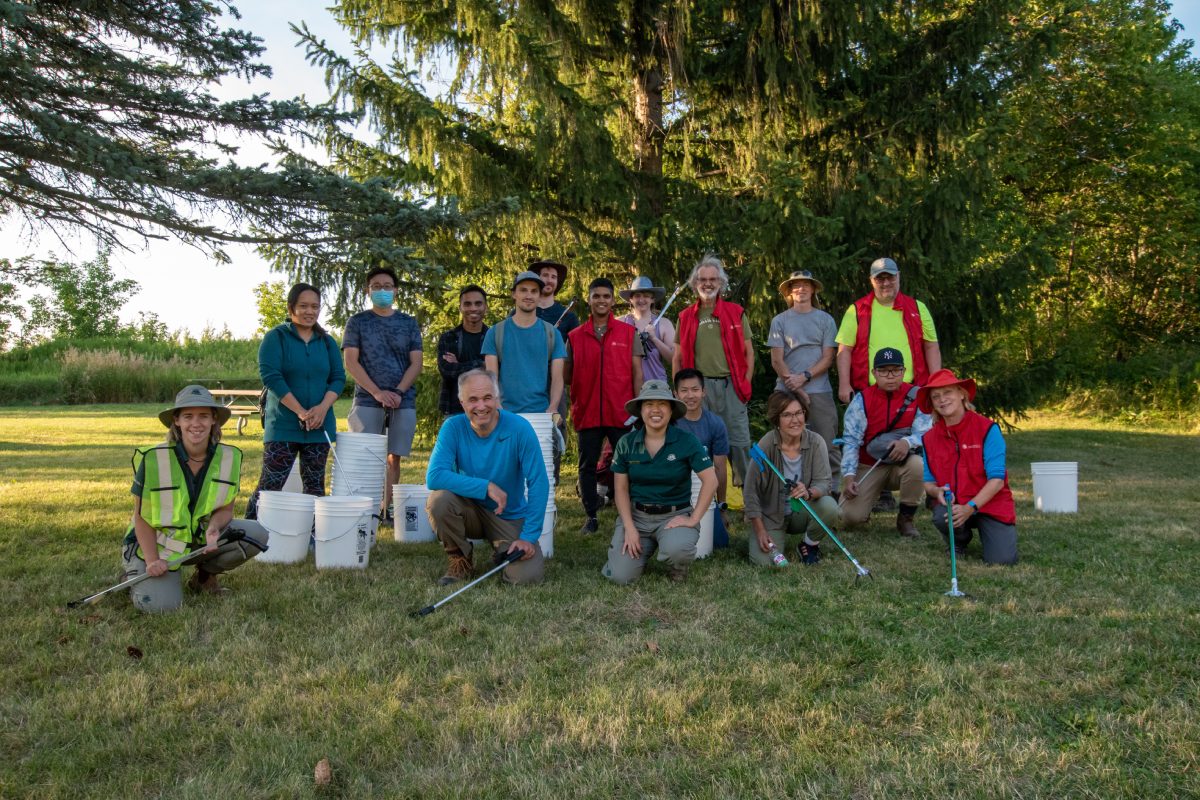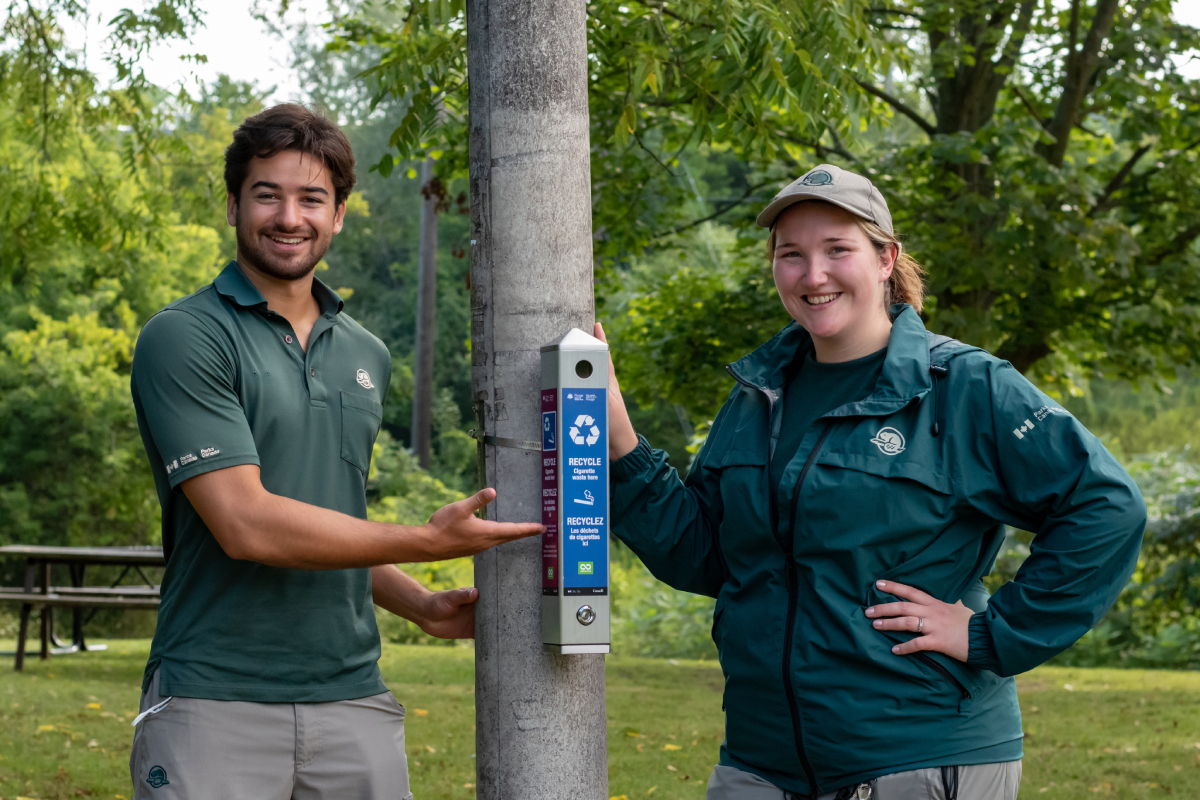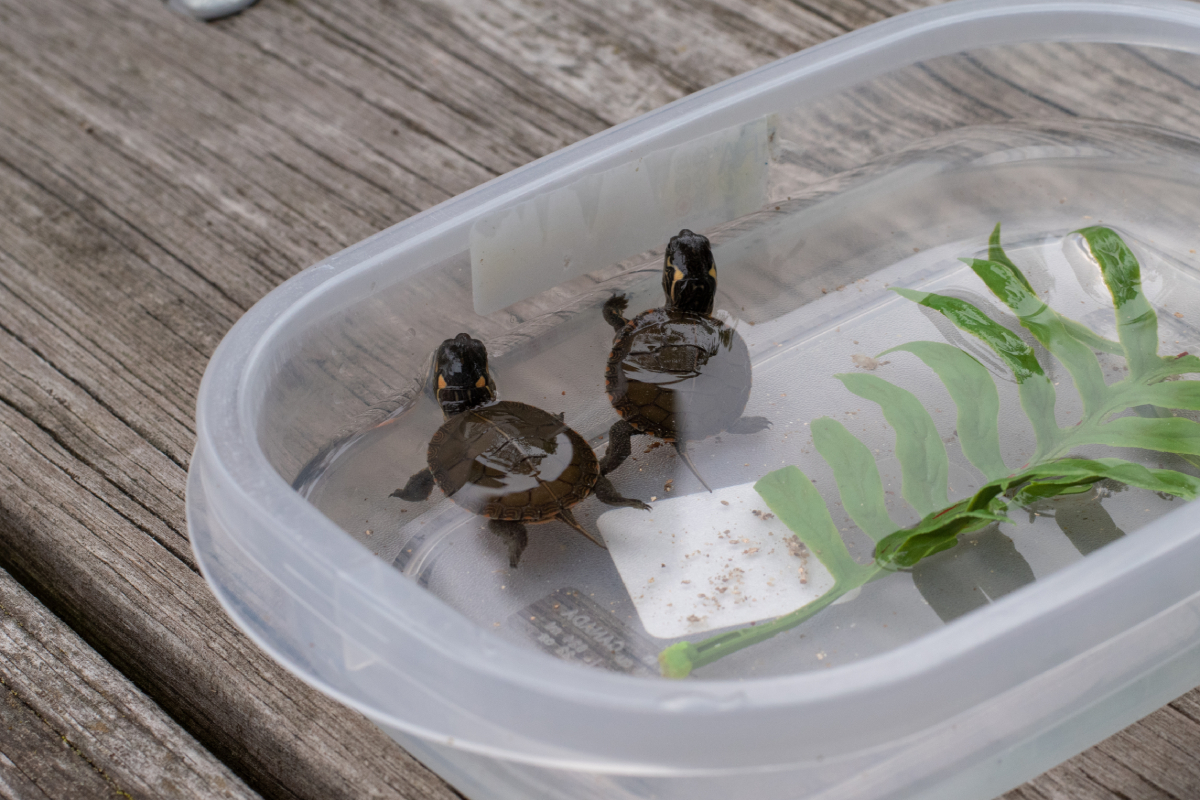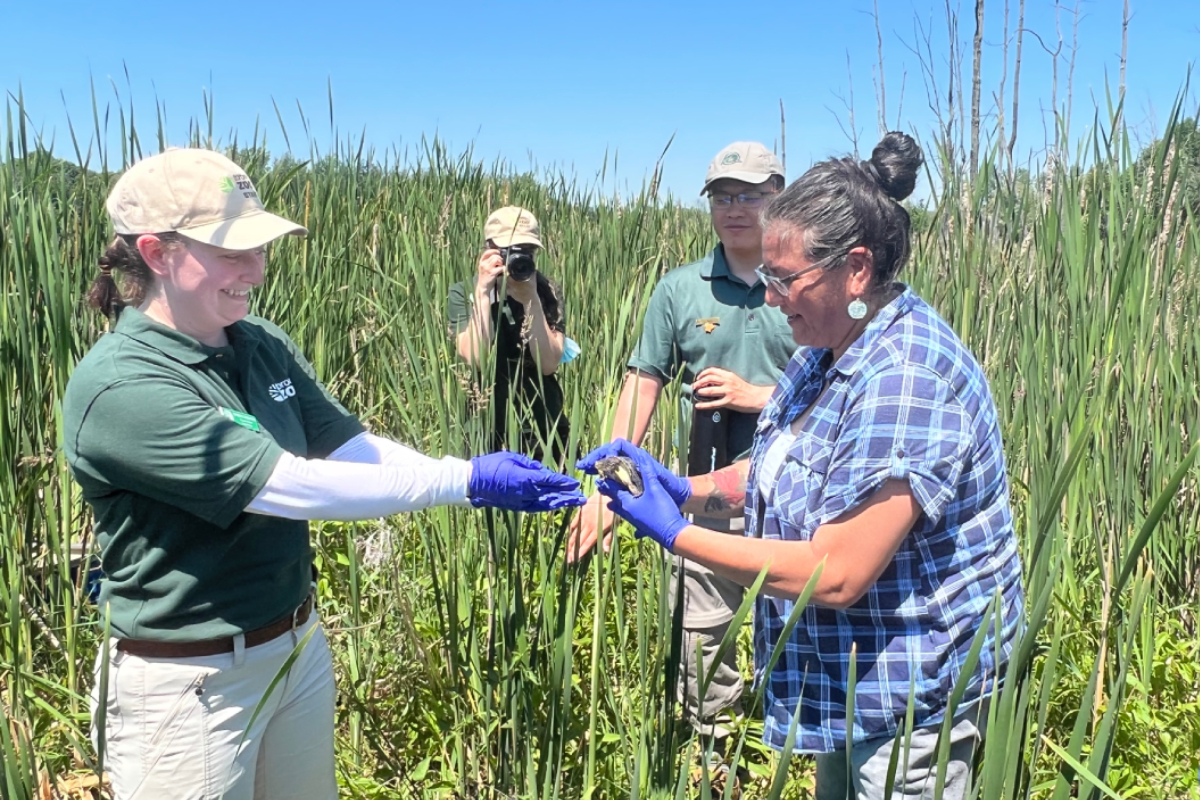2022 Year in Review
Rouge National Urban Park

Looking back
The year 2022 went by in a flash. Time flies when staff are working diligently on conservation initiatives, infrastructure projects and park establishment, all while welcoming thousands of visitors each week. We were thrilled to resume in-park activities, initiatives and services that united staff, volunteers and visitors alike. We rolled up our sleeves to build new gardens, pick up litter and remove invasive species. We launched new programs and resumed old favourites, and we made lots of headway on infrastructure projects and trail building.
The park has many accomplishments to celebrate. Let’s count the ways we worked together to improve Rouge National Urban Park in 2022:
- Launched a new community garden pilot program at Bob Hunter Memorial Park
- Planted 46,000 trees and shrubs in partnership with Toronto and Region Conservation and 10,000 Trees as part of the 2 Billion Trees Program
- Launched a cigarette butt recycling program, the first of its kind in Parks Canada
- Improved parking, facilities and the trail network at Twyn Rivers
- Launched a new downloadable park map
- Resumed the popular Guided Walk program
- Created new and exciting opportunities to get involved and volunteer with our Stewardship Squad
- Published the What We Heard Report and released the draft Detailed Impact Assessment for the Rouge Beach Improvements Project
- Released the What We Heard Report to inform design and function priorities for the new visitor, learning and community centre
In 2022
- 10 km of fishing line recycled
- 67 stewardship volunteers
- 136 Guided Walks led by volunteers
- 23 kilometres of trail completed
- 5,700 cigarette butts recycled
Since 2015
- More than 211,473 native trees & shrubs planted
- More than 600 Blanding’s turtles reintroduced
Restored
- Over 85 hectares of wetland, stream & riverbank habitat
- 114 hectares of forest habitat
- 753 metres of stream habitat
- 5 hectares of meadow habitat

Park and project milestones
Twyn Rivers on track
In spring 2022, Parks Canada closed Twyn Rivers to complete enhancements to the day use area, parking, facilities and trail network. The new site will feature major improvements, including a new permanent washroom, increased parking and over 150 newly-planted native trees and shrubs. Lastly, a new trail alignment will remove dangerous on-road crossings and include a new one-kilometre section of trail. We are proud of these important enhancements that will contribute to a safer and more accessible hiking experience for all. Read more, including recent updates, about this project on our website.
.jpg?h=800&w=1200&hash=9637C435369CE49C8FD65CD8F5BAEA3C)
Rouge Beach Improvements Project
Following a 15-month public engagement on the Rouge Beach Improvements Project, a summary of the feedback received was compiled and released in a What We Heard Report for the project. At the same time, a draft Detailed Impact Assessment (DIA) was made available to the public for comment. During the draft DIA’s public review period, Parks Canada received almost 200 comments from individuals and community groups, as well as non-profit and other regional government organizations.
Parks Canada sincerely thanks all those who took the time to comment and share their opinions, ideas and suggestions to improve the long-term ecological health, accessibility and sustainable management of the Rouge Beach and Marsh.
Rouge Beach – Shoreline remediation
In spring 2022, a natural sandbar emerged at Rouge Beach that blocked the flow of the Rouge River into Lake Ontario. The event caused significant erosion and loss of beach, as well as high water levels that posed risks to public safety and infrastructure. This unfortunate situation required a temporary closure of the beach area for remediation work, completed by Toronto and Region Conservation Authority.
While remediation work was expected to get underway in early summer, nature had other plans. Parks Canada team members discovered common terns nesting on the exposed sandbar and delayed work to protect the nest. The terns were monitored until they finally fledged and took flight with their family.
In August, the remediation work was successfully completed and the traditional outflow of the river into Lake Ontario was restored. These drone images captured how much beach was lost and then regained.
.jpg?h=800&w=1200&hash=384B8576B38CEB502C8DCAB69CBB06A1)
Visitor, learning and community centre
Building on co-design with the Rouge National Urban Park First Nations Advisory Circle and Indigenous co-creators, Parks Canada conducted eight weeks of public engagement on the early design concepts for the new visitor, learning and community centre. In August, Parks Canada shared a What We Heard Report summarizing the feedback received on the design and function priorities for the new site.
Architects, engineers and interpretive consultants have worked hard to transform the site concept into schematic design drawings that will continue to be refined ahead of construction.

In the park
Community gardens
2022 saw the launch of many new in-park programs, but perhaps the most exciting one has long been in the making: the community garden. This year, the pilot community garden at Bob Hunter Memorial Park consisted of seven large plots tended to and cared for by community groups and Parks Canada staff. Producing plants from heirloom vegetables to beautiful pollinating flowers, the garden provided a perfect backdrop for gardening workshops. Native Child and Family Services Toronto shared fascinating stories around the Indigenous gardening traditions and Three Sisters planting. The Markham Butterflyway Rangers shared tips on attracting pollinators. A timely autumn seed-saving workshop by Vicki’s Veggies provided valuable guidance on the process of preparing for the next year. The community garden grew more than just plants — it also fostered a network of passionate stewards that we look forward to expanding in the coming years.
Squad goals
In 2022, the Rouge recruited a new volunteer squad of superheroes to support an ever-widening range of stewardship activities in the park. The formidable “Stewardship Squad” launched in July, and its 67 volunteers removed over 220 pounds of litter from park lands and waters, planted 100 trees, tended to gardens and cleared over 600 m2 of invasive buckthorn. And that’s not all — arguably their coolest accomplishment was turning an old building foundation into snake hibernaculum. It’s amazing what can be accomplished as a team!

Clear Your Gear catches on
In 2021, Rouge joined the Clear Your Gear recycling network, seeking to reduce the amount of fishing line and gear left in the environment. The program enjoyed another successful year in 2022 and a groundswell of interest from other sites looking to adopt the program, including the City of Pickering. Last year, staff collected 1.4 kg of fishing line from the receptacles in the park, equivalent to approximately 10 km of line — the distance from Rouge Beach to Bob Hunter Memorial Park!
Cigarette butt recycling program
Did you know that cigarette butts are the most significant contributor to plastic litter worldwide and the top source of litter across Parks Canada places? To protect the lands, waters and wildlife in Rouge National Urban Park, Parks Canada proudly rolled out a new cigarette butt recycling program in 2022 — the first of its kind across the agency.
As part of the pilot, six receptacles were installed at various locations around the park, including Rouge Beach. To date, staff have collected 2.5 pounds of cigarette butts from the receptacles — equivalent to about 5,700 butts.
The pilot program has generated interest from other national parks and sites and was featured in a poster at the International Marine Protected Areas Congress (IMPAC5) highlighting all the great work that Parks Canada is doing across the country. Hats off to Rouge National Urban Park staff for blazing a trail with this initiative and inspiring other places to adopt the program!

Paid parking pilot program
In 2022, Parks Canada implemented a four-month paid parking pilot at the Zoo Road Day Use Area as part of its strategy for sustainable tourism and responsible visitor use management in Rouge National Urban Park.
Parks Canada received over 500 comments from the public, partners and stakeholders that will help inform future considerations for paid parking. Parks Canada sincerely thanks the many visitors who took the time to provide their constructive feedback about the program as we continue to manage traffic congestion and promote alternate modes of transport.
New trails, new map, new names
Fall 2022 was full of warm, dry days, and visitors flocked to the park to take in the fall colours. At the Zoo Road Day Use Area alone, Parks Canada staff greeted over 7,600 visitors on weekends in October! This proved the perfect time to launch a new downloadable map on the Rouge National Urban Park website. The map includes over 20 km of new trail sections completed in 2022.
Some informally-named areas were given new permanent names, including the day use area at the corner of Reesor Road and Elgin Mills, now known officially as the Black Walnut Day Use Area. The black walnut tree is native to eastern North America and has provided nourishment since time immemorial. For Indigenous Peoples stewarding the lands known today as Rouge National Urban Park, black walnut trees indicate soils of good quality and its seeds are a rich source of protein and essential fats.

Conservation gains
Tree planting
Did you know that Parks Canada and partners planted more than 46,000 trees in Rouge National Urban Park in 2022 as part of the 2 Billion Trees program?
As in previous years, this was a huge joint effort in collaboration with the Toronto and Region Conservation Authority and 10,000 Trees, which resulted in a special fall planting event that welcomed over 300 energetic volunteers. Together, we rolled up our sleeves to plant over 1,200 native trees and shrubs in Glen Rouge Campground to improve the quality and privacy of the site. A special blessing and smudging ceremony by Anishinaabe cultural consultant, speaker and grandmother Kim Wheatley inspired thoughtful planting and deep gratitude for the nature that we’re working hard to restore.
Stream alignment
In collaboration with the Toronto and Region Conservation Authority, Parks Canada completed restoration projects on two tributaries of the West Duffins Creek Watershed in Rouge National Urban Park. This work focused on restoring the natural grade and alignment of streams and stabilizing the base flow of channels to ensure healthy ecosystem functions. The aim: to improve wetland capacity to filter run-off and reduce the downstream movement of sediments and nutrients. These improvements will also serve to improve habitat condition and connectivity for coldwater fish and other wildlife. A huge restoration win!
Pauline Browes fellowship
Now in its fourth year, the Pauline Browes Future Conservation Leaders fellowship empowers emerging conservation leaders to learn and grow through valuable work experience in Rouge National Urban Park.
Congratulations to Keira McManus, the 2022 recipient of the fellowship. In her fellowship submission, McManus comments on what it takes to be a responsible environmental steward:
“Environmental stewardship requires a foundation of community and the collaboration of diverse perspectives. Being an environmental steward means being an active member in the community that uplifts others and displays a positive example for future environmental stewards.”
The Waterfront Regeneration Trust created the fellowship to recognize the tremendous contribution Pauline Browes has made and continues to make to protect and restore the Rouge Valley, and ultimately secure its designation as Canada’s first national urban park.

Turtle nest collection program
2022 marks the third year of the turtle nest collection program in Rouge National Urban Park, advancing turtle protection through monitoring, collecting, incubating and releasing hatchlings back into the park. This year, a total of 170 snapping turtle and midland painted turtle hatchlings were released with an 89% success rate.
In addition, a Blanding’s turtle nest was located in 2022, with eggs collected and transferred to the Toronto Zoo for incubation as part of the Head Start program. These hatchlings will be nurtured for two years before being released, giving them a better chance of survival. We are so proud of the work being done in collaboration with the Toronto Zoo to rebound and grow their population!
Big props to the more than 20 new volunteers who diligently monitored dedicated areas throughout the nesting season as part of the new volunteer nest monitoring program.

.jpg)
Indigenous Leadership
Blanding’s turtle release
2022 marked the ninth year of the Blanding’s Turtle Head Start program, in partnership with the Toronto Zoo. Indigenous and community partners joined staff to release 56 juvenile Blanding’s turtles in honour of National Indigenous Peoples Day. We are proud of the continuing efforts to support this threatened species, including the release of more than 600 turtles since the program began.

Species at risk monitoring
In 2022, biologists from Bureau du Nionwentsïo, Huron-Wendat Nation, conducted species at risk wildlife surveys at 18 buildings in the park that are scheduled to undergo alterations. Surveys were conducted in the evenings and determined which species actively use each building as habitat, with a focus on barn swallows, chimney swifts and bats. The data collected will inform mitigation measures for wildlife when scheduled work moves forward.
National Day of Truth and Reconciliation
On September 30, Indigenous peoples, community members and government representatives came together at Glen Rouge Campground for a tree planting to honour the National Day for Truth and Reconciliation and Orange Shirt Day. Reflection and public commemoration of the painful history and impacts of residential schools are integral to the reconciliation process. Thank you; merci; miigwech; Nya:weh to all who attended.
Archaeology
2022 was a busy year for archaeology team members, who, in collaboration with liaisons from the Huron-Wendat First Nation and Mississaugas of the Credit First Nation, conducted 21 weeks of field work in the assessment of 17 separate areas of the park. As a result, three new archeological sites were identified in 2022.

Vibrant Farming Community
Canadian Foodgrains Bank program
Did you know that a network of farmers and farm suppliers in RNUP volunteer their time each year, producing grain from over 65 acres of farmland for the Canadian Foodgrains Bank program?
The Canadian Foodgrains Bank program aims to reduce hunger worldwide and provide assistance where it’s needed the most. Initially, the program shipped Canadian grains overseas to help combat world hunger. Today, the program has adopted a more sustainable model, producing and selling grains locally. Proceeds are matched by the Canadian government at a ratio of 4:1 and distributed to communities around the world experiencing food insecurity. Funding also supports food and farm programs and the promotion of best farming practices to maximize water, sun and soil fertility.
In 2022, grains grown in the Rouge raised a total of about $200,000 of grain for the program. A huge thank you to farmers in Rouge National Urban Park for continuing this tradition of giving for twenty years and counting!

Partners and outreach
Learn-to Camp
The Learn-to Camp team had a busy summer, engaging with over 10,000 people. Visitors may have seen the enthusiastic student team at info booths throughout the park or in surrounding communities promoting the benefits of spending time outdoors. The team was thrilled to return and meet people face-to-face and particularly enjoyed chatting with visitors who shared their personal memories and connections to the Rouge over its long history.

Thank you for riding the Rouge Express
Parks Canada was excited to see the Parkbus Rouge Express resume its free shuttle service from downtown Toronto in the summer and fall months. At full capacity each trip, many visitors opted to use sustainable transit to enjoy day trips to the Zoo Road Day Use Area. Parks Canada is committed to supporting initiatives like Parkbus and the NatureLink program to remove barriers and expand access to nature and sustainable transit in the region.
- Date modified :